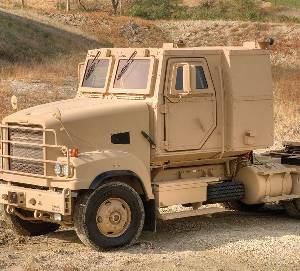Articles >>
Army Armors More Heavy Tactical Trucks
Category: Army

Arlington, Va. -- The Army has introduced modular, add-on armor capability to key portions of its fleet of heavy tactical trucks to include the new M915-A5 Line-Haul Tractor, Palletized Load System PLS-A1, and Heavy Equipment Transporter HET-A1, service officials said. "These vehicles are designed so you can take armor off during peacetime to reduce the burden on the platform itself -- as well as drive down the peacetime operating costs," said Col. David Bassett, project manager for Tactical Vehicles. The move toward scalable armor for medium and heavy tactical vehicles is part of the Army's Long Term Armor Strategy articulated in its recently released 2011 Tactical Wheeled Vehicle Strategy - a document which lays out the Army's plans for its 290,000 vehicle-strong tactical fleet through 2025. "The truck fleet that the Army has and is continuing to field today is really different than the one we went into these conflicts with. We've gone from having what was almost a completely un-armored fleet to one in which every vehicle that is used operationally overseas today is armored against the threats that face our Soldiers. We've rapidly modernized our fleet," said Bassett. These new armored trucks represent the most recent addition to a large TWV fleet of trucks already equipped with modular armor, including the new Family of Medium Tactical Vehicles and the Heavy Expanded Mobility Tactical Trucks, know at HEMTTs. The modular armor approach - explained as an A-kit plus B-kit solution - allows a truck with a small amount of built-on integrated armor to accept additional add-on armor when dictated by the threat environment. "In accordance with our Army modernization strategy, we are going to procure trucks that are adaptable so that they can be used in many different environments. They will have the ability to accept armor and then relinquish that armor when it is no longer needed," said Maj. Gen. Tom Spoehr, director of force development, Army G-8. The modular armor strategy is designed to allow for the rapid incorporation of newer, potentially lighter-weight armor composites as technology progresses and makes them available, Spoehr said. "They will be able to accept new forms of armor as science and industry produce new materials," he said. "These vehicles will have growth potential." |
US Army |
QinetiQ and Pratt Miller Deliver First Robotic Combat Vehicle - Light to U.S. Army
02.02.2021
ARMATA MBT - problems 2020
24.12.2020
Problems of Russian land military vehicles with diesel engines
24.12.2020
General Dynamics Ordnance and Tactical Systems
Kawasaki Heavy Industries, Ltd
Stewart & Stevenson Tactical Vehicle Systems UK Ltd.
Bharat Heavy Electricals Ltd. - BHEL
Kia Heavy Industries Corporation
Drakensberg Truck Manufacturers - DTM
Abdallah Al Faris Company for Heavy Industries
Rockwell International Tactical Systems Division
Ishikawajima-Harima Heavy Industries Co., Ltd.
Volvo Truck Corporation Powertrain Division Engine
Volvo Truck en Bus Nederland B.V.
Volvo Truck & Bus (Thailand) Co Ltd
Mitsubishi Heavy Industries Ltd (MHI)
Bharat Heavy Electricals Ltd. Industry Sector
U.S. Army Simulation, Trading and Simulation Command
Larsen & Toubro Limited, Heavy Engineering Division - L&T
HYUNDAI HEAVY INDUSTRIES CO., LTD.
DOOWON HEAVY INDUSTRIAL CO., LTD.
TONGIL HEAVY INDUSTRIES CO., LTD
TONGMYUNG HEAVY INDUSTRIES CO., LTD - THI
DOOSAN HEAVY INDUSTRIES & CONSTRUCTION CO., LTD.
HAN JIN HEAVY INDUSTRIES & CONSTRUCTION CO., LTD.
THE ASSOCIATION OF THE U.S. ARMY - AUSA
International Truck and Engine Corporation
Ultra Electronics – Tactical Communications Systems
International Truck and Engine Corporation
U.S. Army Armament Research, Development and Engineering Center (ARDEC)
Blauer Tactical Systems, Inc. - BTS
Ultra Electronics – Tactical Communications Systems
Armored Vehicles & Heavy Equipment Factory (AVF)
Granite Tactical Vehicles Inc.
TM TACTICAL VEST (Body Armour)
HAFEET Gun Truck (Fire support vehicle)
Discuss
